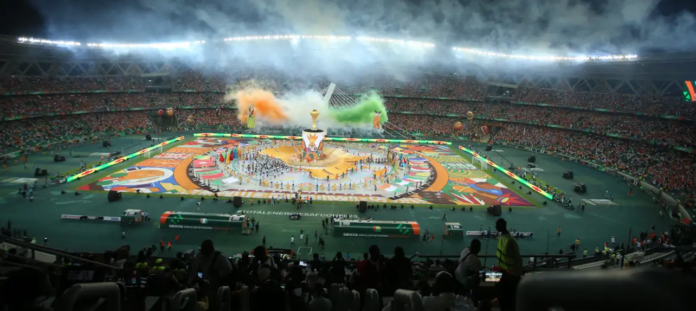After Ivory Coast’s 2-1 victory over Nigeria inside the Allasane Ouattara Stadium, it might take the host country a little longer to return to everyday life. The hosts’ victory was the final act in one of the most memorable Africa Cup of Nations (AFCON) in history.
But once the celebrations have ended, questions will be asked about the future of the shiny new stadiums the country built to host this 24-team tournament. Ivory Coast spent over $1 billion (€927 million) to prepare four new stadiums and renovate two others as well as build roads, hotels and other amenities for the month-long football tournament.
The world’s biggest cocoa producer invested a great deal into hosting 2023 AFCON. Supported by Chinese investment and construction companies, the four new stadiums in San Pedro (20,000 seats), Yamoussoukro (20,000), Korhogo (20,000) and Abidjan’s Alassane Ouattara (60,000) will remain as landmarks long after the games are done.
Past hosts have experienced stadium neglect, but those in charge in the Ivory Coast have a dream.
“Ivory Coast will become a hub in the sub-region,” Idris Diallo, president of the Ivory Coast Football Federation (FIF), told Reuters. “All countries in the sub-region that do not have approved stadiums will be welcome.”
That might work occasionally, but it is not a sustainable plan to keep the stadiums engaged all year round.
The Alassane Ouattara Stadium hosted the final of AFCON 2023, but how much use will it get in future?Image: Braima Darame/DW
- AFCON’s legacy of abandoned stadiums
Since AFCON grew from a 16-team tournament to 24-teams in 2019, bidding countries have been required to provide more venues. Previously, the Confederation of African Football (CAF) requested four stadiums, but now, at least six must be presented. This has led to the construction of stadiums that often end up underutilized after the tournament’s final whistle.
A lack of a legacy plan for the stadiums after AFCON tournaments is one of the reasons behind their abandonment, says Adedamilola Adedotun, sports finance expert and head of sports at Lagos-based agency Temple Company.
“What is important is to have a legacy plan for the infrastructure post-event. That is where African host nations struggle,” Adedotun told DW.
Cameroon presented six stadiums for the last tournament. They handed over the management of the facilities to the National Office of Sports Infrastructure and Equipment (ONIES) to preserve the event’s legacy.
There has been a battle between the Cameroon Football Federation and ONIES over the use of the facilities due to the lack of payment of fees. However, attendances at domestic games are quite small compared to the capacity of their 40,000-seat stadiums.
- Decaying infrastructure
A sore point on the legacy of AFCON infrastructure is the decay of the once brand-new Essipong Stadium in Sekondi, one of four stadiums used for the 2008 tournament in Ghana.
A $40 million project has been abandoned to rot. Its roof has caved in, the toilets are broken, and it needs a better pitch. The Ghanaian government has said it needs about $3 million to restore it.
“Maintaining infrastructure is a full-time job. There needs to be a commitment to maintain infrastructure. Still, we need to invest regularly to make it last long,” said Mohsen Abdel Fattah, managing director of the Johannesburg-based African Sports & Creative Institute, a sports industry think tank.
- Surplus to demand
This abandonment also makes it clear that many African countries are building stadiums that they do not need as even domestic football cannot maximise their use.
ASEC Mimosas, Ivory Coast’s biggest club side, have been playing their home games in Africa’s Champions League at the 33,000-seater Felix Houphouet Boigny Stadium in Abidjan. But the stadium is rarely filled to even half capacity.
Sports infrastructure expert Reda Laraichi of Paris-based Rainbow Sports Global says that host countries must try to build smaller stadiums that are easier to maintain instead of bigger ones.
“We must think about the Stadium 2.0 model adapted to Africa, where stadiums can adapt to capacity, whether to increase or decrease based on need. It will lower the cost of maintenance,” Laraichi said.

ASEC Mimosas regularly play in front of small crowds at the Felix Houphouet Boigny Stadium in AbidjanImage: Mohamed Aly/picture alliance/empics
- The future is co-hosting
The next AFCON is to be hosted in 2025 by Morocco, a country that has already presented six existing stadiums for the tournament and boasts some of best facilities on the continent.
However, the tournament after that, in 2027, will break new ground in that it brings together three countries as joint hosts for the first time. East African nations Kenya, Tanzania and Uganda will each supply three existing stadiums for the tournament.
For a 24-team AFCON, joint hosting is a way to resolve the pressure of delivering new stadiums that is put on bidding countries. The next two FIFA World Cups — 2026 in US, Canada and Mexico and 2030 in Spain, Portugal and Morocco — will also be hosted by multiple countries.
“It makes more sense to co-host and share costs and investments,” says think-tank director Abdel Fateh.
“If the Europeans and the Americans are doing it, I would say Africans should do it, even though we have our specific challenges.”
These challenges include overcoming the difficulty of travelling across African borders and low trade among African countries. However, if countries are to avoid the curse of abandoned multi-million-dollar football stadiums, they must make joint hosting the norm.

